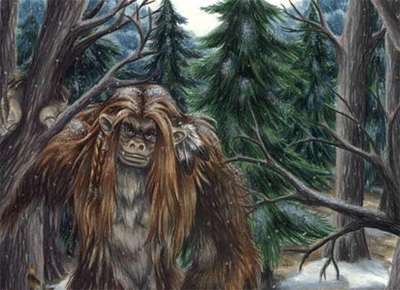The Manufacture of Chinese Wildmen May 4, 2015
Author: Beach Combing | in : Modern , trackbackThis comes from a British newspaper and 1892. It appeared in a curiosity column along with an item on marrying trees (really!). All this to say that this material should probably be treated with circumspection if not downright superstition. Or perhaps someone recognizes an obscure Chinese custom or institution: drbeachcombing AT yahoo DOT com Beach would love to know.
There are many curious trades in the world, but the most strange must surely be the ‘artificial manufacture of wild men.’ Yet a well known English doctor in China has just certified from his own personal experience that this art is regularly practised in the Flowery Kingdom. First a youth is kidnapped, then bit by bit he is flayed alive, and the skin of a dog or a bear is grafted piece by piece upon him.
Think this is bad. Wait for what follows.
His vocal chords are next destroyed by the action of charcoal to make him dumb, and the double purpose of causing ‘atiolation’ of the skin and utter depredation of the mental faculties is effected by keeping him immured in a perfectly black hole for a number of years. In fact, by treating him like a brute for a sufficiently long time he is made into one. At last he is exhibited to the entirely credulous Chinese as a wild man of the woods, and his possessors reap a rich harvest.
Interesting to see an English journalist laughing at the credulity of the Chinese when the English proletariat were happy to give their pennies to see ‘the wild man of Borneo’ and other invented wonders. Still were there records of ‘wild men’ being exhibited in China in the nineteenth century? Imagine what a cryptozoologist would make of this… The pictures that heads the post is of a ‘Deren’ or wild man: the Chinese reflex of Yeti. As Wikipedia helpfully explains: ‘it is also thought that the Yeren might just be a legend.’ The 1892 article continues, meanwhile:
The priests, it seems, are adepts at the art. When a kidnapper, however, is caught by the people he is torn to pieces, and when the authorities get him they torture him and behead him.
Beach wondered vaguely whether what we have here is one of these child-stealing myths, previous examples we’ve seen related to the Roma and to fairies (in Ireland) and to other supernatural beings in Spain. There seems to be concomitant hysteria in the account above.
31 May 2015: ANL writes in ‘I hope that I don’t need to point out that grafting the skin of a dog or bear onto a human being is quite impossible, a fact which was not known in 1892. The human immune system will not allow it. Did this sceptical European witness something out of the ordinary and try to explain it away by drawing a parallel with the fake mermaids produced in the Far East at that time? Note the blithe assumption of (sceptical European) superiority in the phrase “the entirely credulous Chinese”. Also, the statement that “depredation of the mental faculties is effected by keeping him immured in a perfectly black hole for a number of years” sounds like a rationalisation; in reality, this only happens if the mental faculties are never developed in the first place, as in so-called “feral children”, who are removed from human society as toddlers but somehow manage to survive to adulthood. DNA evidence from Abkhazia has recently demonstrated that Zana, the most famous “wild man” (actually a woman) captured in the 19th century, was actually from sub-Saharan Africa. Her reported mental capacities are typical of a feral child and indicate that she was abandoned before she learnt to speak. How she got to Abkhazia in the first place is a moot point, but it is hardly surprising that a bunch of Abkhazian mountain men, who had never seen or even imagined black people, thought she was a wild person. European reports of “wild men” in the Far East go back to 1420, when, as a prisoner of the Mongol Khan, Hans Schiltberger recorded his personal observation of these creatures in Mongolia.



